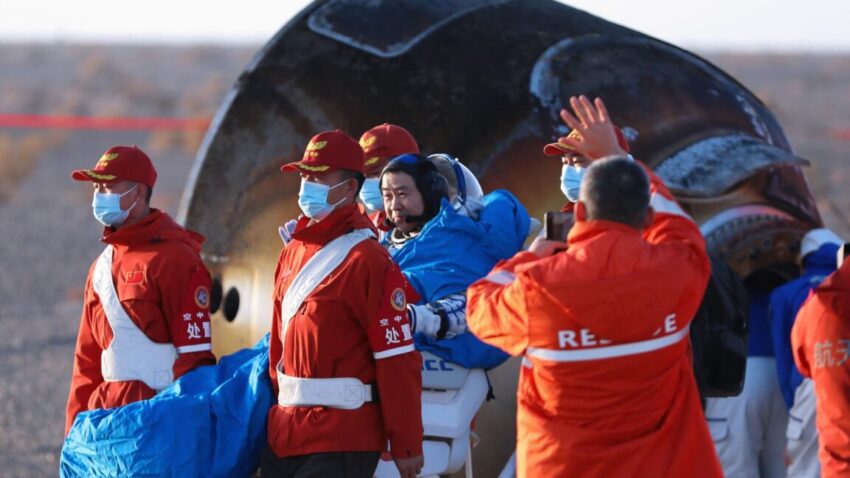
three astronauts are stuck on china s Three astronauts have concluded their mission in orbit but face a precarious situation as they leave behind three crewmates on China’s Tiangong space station due to a malfunctioning lifeboat.
three astronauts are stuck on china s
Mission Overview
On Friday, following an extensive 204 days in orbit, three Chinese astronauts successfully returned to Earth aboard the Shenzhou spacecraft. The crew, consisting of Commander Chen Dong, along with rookie astronauts Chen Zhongrui and Wang Jie, landed safely at the Dongfeng landing zone at 1:29 am EST (06:29 UTC). This marked a significant milestone in China’s growing space exploration efforts, as the astronauts had spent nearly seven months aboard the Tiangong space station.
Landing Details
The landing of the Shenzhou spacecraft was executed with precision, utilizing a parachute-assisted descent that concluded in the remote Gobi Desert of northwestern China. This area is often chosen for landings due to its vast, unpopulated expanses, which provide a safer environment for re-entry operations. The successful return of the astronauts was celebrated by the China Manned Space Agency (CMSA), which oversees the nation’s space missions.
Current Situation on Tiangong
While the return of the three astronauts was a triumphant moment for China’s space program, it was overshadowed by the troubling situation left behind on the Tiangong space station. Three additional astronauts remain on board, facing an uncertain future due to damage discovered in one of the two Shenzhou return capsules docked at the station. This malfunction has left them without a safe means of returning to Earth.
Discovery of Damage
The issues with the lifeboat were identified shortly before the scheduled departure of the three astronauts. On November 4, just a day before the planned return, the CMSA announced a change in the flight plan, indicating that the damaged capsule would not be available for use. This unexpected development has raised concerns regarding the safety and well-being of the astronauts still aboard the station.
Implications of the Situation
The current predicament poses several implications for China’s space program and its future missions. The Tiangong space station is a crucial component of China’s ambitions in space exploration, and the safety of its astronauts is paramount. The malfunction of the lifeboat raises questions about the reliability of the spacecraft and the protocols in place for ensuring astronaut safety.
Operational Adjustments
In response to the situation, the CMSA is likely to conduct a thorough investigation into the cause of the damage. This may involve analyzing the design and manufacturing processes of the Shenzhou spacecraft, as well as reviewing the maintenance protocols for the space station. The agency may also need to adjust its operational plans to ensure that future missions are not similarly compromised.
Reactions from Stakeholders
The situation has drawn reactions from various stakeholders, including space experts, government officials, and the general public. Many are expressing concern over the safety of the astronauts still aboard the Tiangong space station. The international space community is closely monitoring the developments, as the incident raises broader questions about space safety and the challenges of long-duration missions.
Expert Opinions
Space analysts have pointed out that while the Tiangong space station represents a significant achievement for China, the current situation underscores the inherent risks associated with human spaceflight. Experts emphasize the importance of robust safety measures and contingency plans to address potential emergencies. They also highlight the need for transparent communication from the CMSA regarding the status of the astronauts and the steps being taken to resolve the issue.
Future of the Tiangong Space Station
The Tiangong space station is designed to be a modular facility that can support long-term human habitation and scientific research. It is part of China’s broader strategy to establish a permanent presence in low Earth orbit and contribute to international space exploration efforts. However, the current situation poses challenges to these ambitions.
Upcoming Missions
Despite the setback, China is expected to continue its plans for future missions to the Tiangong space station. The CMSA has outlined a series of upcoming launches aimed at expanding the station’s capabilities and conducting scientific experiments. However, the timeline for these missions may be affected by the need to address the current lifeboat issue and ensure the safety of all astronauts involved.
Conclusion
The return of three astronauts from the Tiangong space station marks a significant achievement for China’s space program, but it is tempered by the serious situation facing their crewmates left behind. The discovery of damage to a lifeboat has raised concerns about astronaut safety and the reliability of the spacecraft. As the CMSA works to investigate the issue and implement necessary changes, the international space community will be watching closely to see how China navigates this challenge and what it means for the future of its space exploration efforts.
Source: Original report
Was this helpful?
Last Modified: November 15, 2025 at 12:35 am
1 views















